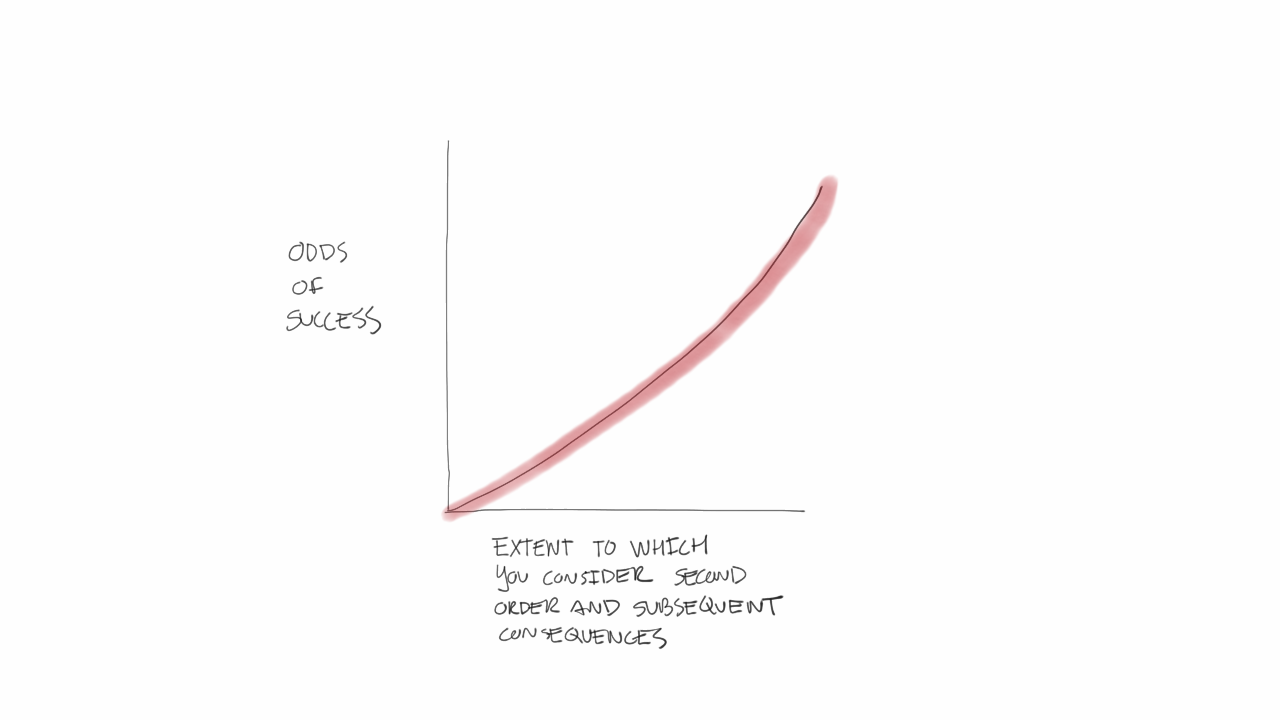
Things are not always as they appear. Often when we solve one problem, we end up unintentionally creating another one that’s even worse. The best way to examine the long-term consequences of our decisions is to use second-order thinking.
事情并不总是表面看起来那样。通常,当我们解决一个问题时,我们最终会无意中创造出另一个更糟糕的问题。检查我们决定的长期后果的最好方法是使用二阶思维。
It’s often easier to identify when people didn’t adequately consider the second and subsequent order impacts. For example, consider a country that, wanting to inspire regime change in another country, funds and provides weapons to a group of “moderate rebels.” Only it turns out that those moderate rebels will become powerful and then go to war with the sponsoring country for decades. Whoops.
当人们没有充分考虑第二个和随后的顺序影响时,通常更容易识别。例如,考虑一个国家,想要激发另一个国家的政权更迭,资助和提供武器给一群“温和的叛乱分子”只是这些温和的反叛分子会变得强大,然后与赞助国开战几十年。哎呀。
“Failing to consider second- and third-order consequences is the cause of a lot of painfully bad decisions, and it is especially deadly when the first inferior option confirms your own biases. Never seize on the first available option, no matter how good it seems, before you’ve asked questions and explored.”
“没有考虑到二阶和三阶后果是许多糟糕决定的原因,尤其是当第一个次要选项证实了你自己的偏见时,这种情况尤其致命。在你提出问题和探索之前,永远不要抓住第一个可用的选择,不管它看起来有多好。”
—Ray Dalio
The ability to think through problems to the second, third, and nth order—or what we will call second-order thinking for short—is a powerful tool that supercharges your thinking.
把问题思考到第二、第三和第 N 级的能力ーー或者我们简称为第二级思考的能力ーー是一种强有力的工具,可以增强你的思考能力。

Second-Order Thinking
二阶思维
In his exceptional book, The Most Important Thing, Howard Marks explains the concept of second-order thinking, which he calls second-level thinking.
霍华德 · 马克斯在他的杰出著作《最重要的事》中解释了二阶思维的概念,他称之为二阶思维。
First-level thinking is simplistic and superficial, and just about everyone can do it (a bad sign for anything involving an attempt at superiority). All the first-level thinker needs is an opinion about the future, as in “The outlook for the company is favorable, meaning the stock will go up.” Second-level thinking is deep, complex and convoluted.
第一层次的思考是过于简单和肤浅的,几乎每个人都能做到(对于任何企图占优势的事情来说,这都是一个不好的信号)。第一层次的思考者所需要的只是对未来的看法,比如“公司前景看好,这意味着股票会上涨。”第二层次的思维是深刻的、复杂的和复杂的。
First-order thinking is fast and easy. It happens when we look for something that only solves the immediate problem without considering the consequences. For example, you can think of this as I’m hungry so let’s eat a chocolate bar.
一阶思维是快速而简单的。当我们寻找一些只能解决眼前问题而不考虑后果的东西时,就会发生这种情况。举个例子,你可以把它想象成我饿了,所以我们来吃一块巧克力吧。
Second-order thinking is more deliberate. It is thinking in terms of interactions and time, understanding that despite our intentions our interventions often cause harm. Second order thinkers ask themselves the question “And then what?” This means thinking about the consequences of repeatedly eating a chocolate bar when you are hungry and using that to inform your decision. If you do this you’re more likely to eat something healthy.
二阶思维更加深思熟虑。它是从互动和时间的角度思考,理解尽管我们的意图,我们的干预常常造成伤害。二阶思考者会问自己“然后呢?”这意味着当你饥饿的时候,想想反复吃一块巧克力的后果,并用它来告诉你的决定。如果你这样做,你更有可能吃一些健康的东西。
First-level thinking looks similar. Everyone reaches the same conclusions. This is where things get interesting. The road to out-thinking people can’t come from first-order thinking. It must come from second-order thinking. Extraordinary performance comes from seeing things that other people can’t see.
第一层次的思考看起来很相似。每个人都会得出相同的结论。这就是事情变得有趣的地方。通向思维超前的人不能来自第一阶段的思维。一定是二阶思维。卓越的表现来自于看到别人看不到的东西。

Improving Your Ability To Think
提高你的思考能力
Here are three ways you can use to put second order thinking into practice today.
这里有三种方法,你可以用来把二阶思维付诸实践。
- Always ask yourself “And then what?”
- 总是问自己“然后呢?”
- Think through time — What do the consequences look like in 10 minutes? 10 months? 10 Years? 1
- 想想时间ーー10分钟、10个月、10年后的结果是什么
- Create templates like the second image above with 1st, 2nd, and 3rd order consequences. Identify your decision and think through and write down the consequences. If you review these regularly you’ll be able to help calibrate your thinking.
- 创建模板,如上面的第二个图像,具有第一、第二和第三顺序的结果。明确你的决定,仔细考虑并写下结果。如果你定期回顾这些,你将能够帮助校准你的想法。
- (Bonus) If you’re using this to think about business decisions, ask yourself how important parts of the ecosystem are likely to respond. How will employees deal with this? What will my competitors likely do? What about my suppliers? What about the regulators? Often the answer will be little to no impact, but you want to understand the immediate and second-order consequences before you make the decision.
- (奖励)如果你用这个来思考商业决策,问问你自己生态系统的重要部分可能会做出怎样的反应。员工将如何处理这个问题?我的竞争对手可能会怎么做?我的供货商呢?监管机构呢?答案通常不会产生什么影响,但是在做出决定之前,你需要了解直接的和次要的后果。
A lot of extraordinary things in life are the result of things that are first-order negative, second order positive. So just because things look like they have no immediate payoff, doesn’t mean that’s the case. All it means is that you’ll have less competition if the second and third order consequences are positive because everyone who thinks at the first order won’t think things through.
生活中很多不寻常的事情都是一阶负数,二阶正数的结果。因此,仅仅因为事情看起来没有立即的回报,并不意味着情况就是这样。这意味着如果二阶和三阶的结果是正面的,那么你的竞争就会减少,因为每个第一阶思考的人都不会把事情想清楚。
Second-order thinking takes a lot of work. It’s not easy to think in terms of systems, interactions, and time. However, doing so is a smart way to separate yourself from the masses.
二阶思维需要大量的工作。从系统、交互和时间的角度来考虑是不容易的。然而,这样做是一个聪明的办法,把自己从群众中分离出来。




评论区